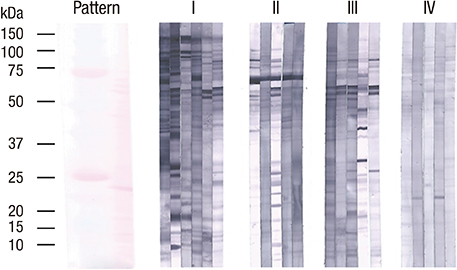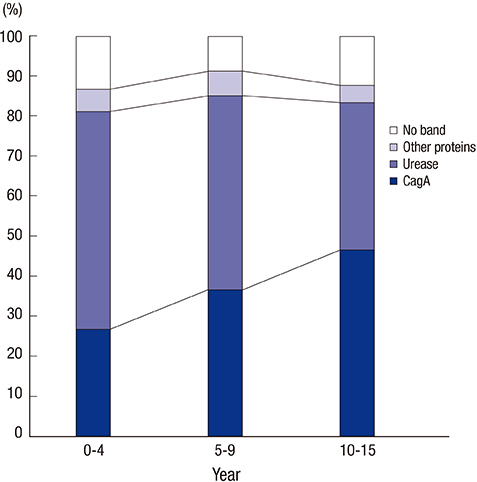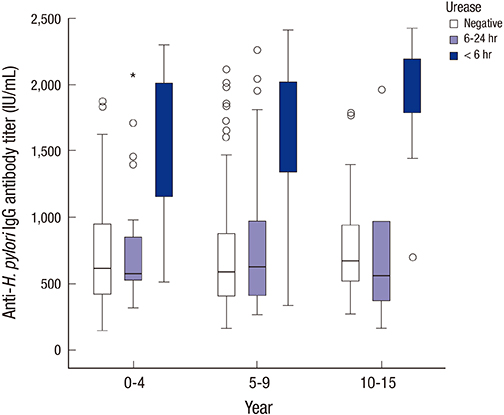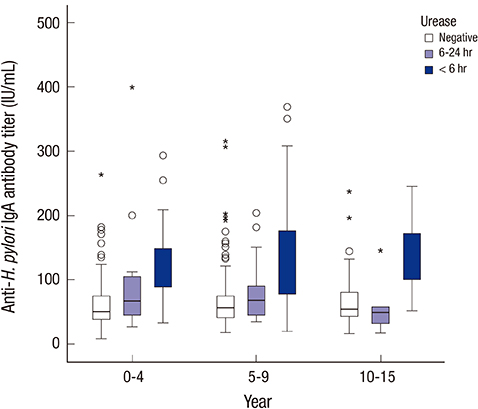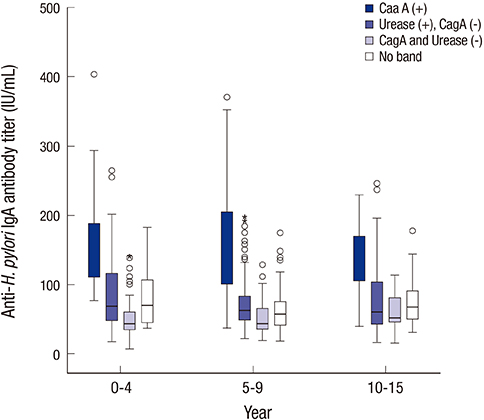J Korean Med Sci.
2016 Mar;31(3):417-422. 10.3346/jkms.2016.31.3.417.
Correlations between the CagA Antigen and Serum Levels of Anti-Helicobacter pylori IgG and IgA in Children
- Affiliations
-
- 1Department of Pediatrics, Gyeongsang National University School of Medicine, Gyeongsang Institute of Health Science, Jinju, Korea. hsyoun@gnu.ac.kr
- 2Department of Microbiology, Gyeongsang National University School of Medicine, Gyeongsang Institute of Health Science, Jinju, Korea.
- KMID: 2363503
- DOI: http://doi.org/10.3346/jkms.2016.31.3.417
Abstract
- We tested correlations between anti-Helicobacter pylori IgG and IgA levels and the urease test, anti-CagA protein antibody, degree of gastritis, and age. In total, 509 children (0-15 years) were enrolled. Subjects were stratified as 0-4 years (n = 132), 5-9 years (n = 274), and 10-15 years (n = 103) and subjected to the urease test, histopathology, ELISA, and western blot using whole-cell lysates of H. pylori strain 51. The positivity rate in the urease test (P = 0.003), the degree of chronic gastritis (P = 0.021), and H. pylori infiltration (P < 0.001) increased with age. The median titer for anti-H. pylori IgG was 732.5 IU/mL at 0-4 years, 689.0 IU/mL at 5-9 years, and 966.0 IU/mL at 10-15 years (P < 0.001); the median titer for anti-H. pylori IgA was 61.0 IU/mL at 0-4 years, 63.5 IU/mL at 5-9 years, and 75.0 IU/mL at 10-15 years (P < 0.001). The CagA-positivity rate was 26.5% at 0-4 years, 36.5% at 5-9 years, and 46.6% at 10-15 years for IgG (P = 0.036), and 11.3% at 0-4 years, 18.6% at 5-9 years, and 23.3% at 10-15 years for IgA (P < 0.001). Anti-H. pylori IgG and IgA titers increased with the urease test grade, chronic gastritis degree, active gastritis, and H. pylori infiltration. Presence of CagA-positivity is well correlated with a high urease test grade and high anti-H. pylori IgG/IgA levels.
Keyword
MeSH Terms
-
Adolescent
Antibodies, Bacterial/*blood
Antigens, Bacterial/*analysis/immunology
Bacterial Proteins/*analysis/immunology/metabolism
Blotting, Western
Child
Child, Preschool
Chronic Disease
Enzyme-Linked Immunosorbent Assay
Female
Gastritis/pathology
Helicobacter Infections/blood/microbiology/*pathology
Helicobacter pylori/isolation & purification/*metabolism
Humans
Immunoglobulin A/*blood
Immunoglobulin G/*blood
Infant
Infant, Newborn
Male
Severity of Illness Index
Urease/metabolism
Antibodies, Bacterial
Antigens, Bacterial
Bacterial Proteins
Immunoglobulin A
Immunoglobulin G
Urease
Figure
Cited by 1 articles
-
Diagnosis of Helicobacter pylori Infection in Children and Adolescents in Korea
Ji-Hyun Seo, Ji-Sook Park, Kwang-Ho Rhee, Hee-Shang Youn
Pediatr Gastroenterol Hepatol Nutr. 2018;21(4):219-233. doi: 10.5223/pghn.2018.21.4.219.
Reference
-
1. McColl KE. Clinical practice. Helicobacter pylori infection. N Engl J Med. 2010; 362:1597–1604.2. Malaty HM. Epidemiology of Helicobacter pylori infection. Best Pract Res Clin Gastroenterol. 2007; 21:205–214.3. Chen TS, Li FY, Chang FY, Lee SD. Immunoglobulin G antibody against Helicobacter pylori: clinical implications of levels found in serum. Clin Diagn Lab Immunol. 2002; 9:1044–1048.4. Schumann C, Triantafilou K, Rasche FM, Möricke A, Vogt K, Triantafilou M, Hahn P, Schneider EM, Lepper PM. Serum antibody positivity for distinct Helicobacter pylori antigens in benign and malignant gastroduodenal disease. Int J Med Microbiol. 2006; 296:223–228.5. de Oliveira AM, Rocha GA, Queiroz DM, Mendes EN, de Carvalho AS, Ferrari TC, Nogueira AM. Evaluation of enzyme-linked immunosorbent assay for the diagnosis of Helicobacter pylori infection in children from different age groups with and without duodenal ulcer. J Pediatr Gastroenterol Nutr. 1999; 28:157–161.6. Raymond J, Kalach N, Bergeret M, Barbet JP, Benhamou PH, Gendrel D, Dupont C. Evaluation of a serological test for diagnosis of Helicobacter pylori infection in children. Eur J Clin Microbiol Infect Dis. 1996; 15:415–417.7. Raymond J, Sauvestre C, Kalach N, Bergeret M, Dupont C. Immunoblotting and serology for diagnosis of Helicobacter pylori infection in children. Pediatr Infect Dis J. 2000; 19:118–121.8. Kindermann A, Konstantopoulos N, Lehn N, Demmelmair H, Koletzko S. Evaluation of two commercial enzyme immunoassays, testing immunoglobulin G (IgG) and IgA responses, for diagnosis of Helicobacter pylori infection in children. J Clin Microbiol. 2001; 39:3591–3596.9. Rocha GA, Oliveira AM, Queiroz DM, Carvalho AS, Nogueira AM. Immunoblot analysis of humoral immune response to Helicobacter pylori in children with and without duodenal ulcer. J Clin Microbiol. 2000; 38:1777–1781.10. Seo JH, Jun JS, Youn HS, Yeom JS, Park JS, Park CH, Woo HO, Lee WK, Cho MJ, Rhee KH. Development of an ELISA for quantitative detection of immunoglobulin G (IgG) and IgA antibodies to Helicobacter pylori for use in Korean pediatric patients with H. pylori-associated diseases. Gut Liver. 2013; 7:437–442.11. Sheu BS, Shiesh SC, Yang HB, Su IJ, Chen CY, Lin XZ. Implications of Helicobacter pylori serological titer for the histological severity of antral gastritis. Endoscopy. 1997; 29:27–30.12. Yokota S, Amano K, Fujii N, Yokochi T. Comparison of serum antibody titers to Helicobacter pylori lipopolysaccharides, CagA, VacA and partially purified cellular extracts in a Japanese population. FEMS Microbiol Lett. 2000; 185:193–198.13. Gao L, Michel A, Weck MN, Arndt V, Pawlita M, Brenner H. Helicobacter pylori infection and gastric cancer risk: evaluation of 15 H. pylori proteins determined by novel multiplex serology. Cancer Res. 2009; 69:6164–6170.14. Satomi S, Yamakawa A, Matsunaga S, Masaki R, Inagaki T, Okuda T, Suto H, Ito Y, Yamazaki Y, Kuriyama M, et al. Relationship between the diversity of the cagA gene of Helicobacter pylori and gastric cancer in Okinawa, Japan. J Gastroenterol. 2006; 41:668–673.15. Jeong HL, Jung YS, Jun JS, Yeom JS, Park JS, Seo JH, Lim JY, Park CH, Woo HO, Youn HS, et al. Comparison of four commercial ELISA kits and in-house immunoblotting for diagnosis of Helicobacter pylori infection. Pediatr Gastroenterol Hepatol Nutr. 2012; 15:85–90.16. Holtmann G, Talley NJ, Mitchell H, Hazell S. Antibody response to specific H. pylori antigens in functional dyspepsia, duodenal ulcer disease, and health. Am J Gastroenterol. 1998; 93:1222–1227.17. Blaser MJ, Perez-Perez GI, Kleanthous H, Cover TL, Peek RM, Chyou PH, Stemmermann GN, Nomura A. Infection with Helicobacter pylori strains possessing cagA is associated with an increased risk of developing adenocarcinoma of the stomach. Cancer Res. 1995; 55:2111–2115.18. Yamazaki S, Yamakawa A, Okuda T, Ohtani M, Suto H, Ito Y, Yamazaki Y, Keida Y, Higashi H, Hatakeyama M, et al. Distinct diversity of vacA, cagA, and cagE genes of Helicobacter pylori associated with peptic ulcer in Japan. J Clin Microbiol. 2005; 43:3906–3916.19. Wong BC, Yin Y, Berg DE, Xia HH, Zhang JZ, Wang WH, Wong WM, Huang XR, Tang VS, Lam SK. Distribution of distinct vacA, cagA and iceA alleles in Helicobacter pylori in Hong Kong. Helicobacter. 2001; 6:317–324.20. Ko JS, Kim KM, Oh YL, Seo JK. cagA, vacA, and iceA genotypes of Helicobacter pylori in Korean children. Pediatr Int. 2008; 50:628–631.21. Akada J, Okuda M, Hiramoto N, Kitagawa T, Zhang X, Kamei S, Ito A, Nakamura M, Uchida T, Hiwatani T, et al. Proteomic characterization of Helicobacter pylori CagA antigen recognized by child serum antibodies and its epitope mapping by peptide array. PLoS One. 2014; 9:e104611.22. Kim EA, Kim YO, Lim JY, Jung YS, Park CH, Woo HO, Youn HS, Ko GH, Baik SC, Lee WK, et al. Antibody response of infants to Helicobacter pylori infection. Korean J Gastroenterol. 2000; 35:704–715.23. Yim JY, Kim N, Choi SH, Kim YS, Cho KR, Kim SS, Seo GS, Kim HU, Baik GH, Sin CS, et al. Seroprevalence of Helicobacter pylori in South Korea. Helicobacter. 2007; 12:333–340.24. Kim HY, Kim N, Kim SM, Seo JH, Park EH, Lee DH. Seroprevalence of Helicobacter pylori infection in Korean health personnel. Gut Liver. 2013; 7:648–654.25. Crabtree JE, Mahony MJ, Taylor JD, Heatley RV, Littlewood JM, Tompkins DS. Immune responses to Helicobacter pylori in children with recurrent abdominal pain. J Clin Pathol. 1991; 44:768–771.26. Corvaglia L, Bontems P, Devaster JM, Heimann P, Glupczynski Y, Keppens E, Cadranel S. Accuracy of serology and 13C-urea breath test for detection of Helicobacter pylori in children. Pediatr Infect Dis J. 1999; 18:976–979.27. Pounder RE, Ng D. The prevalence of Helicobacter pylori infection in different countries. Aliment Pharmacol Ther. 1995; 9:Suppl 2. 33–39.28. Hsu PI, Lai KH, Tseng HH, Liu YC, Yen MY, Lin CK, Lo GH, Huang RL, Huang JS, Cheng JS, et al. Correlation of serum immunoglobulin G Helicobacter pylori antibody titers with histologic and endoscopic findings in patients with dyspepsia. J Clin Gastroenterol. 1997; 25:587–591.29. Chomvarin C, Ottiwet O, Hahnvajanawong C, Intapan PM, Wongwajana S. Seroreactivity to specific antigens of Helicobacter pylori infection is associated with an increased risk of the dyspeptic gastrointestinal diseases. Int J Infect Dis. 2009; 13:647–654.30. Graham DY. Helicobacter pylori and the endoscopist: whether to diagnose. Gastrointest Endosc. 1991; 37:577–579.31. Seo JH, Youn HS, Park JJ, Yeom JS, Park JS, Jun JS, Lim JY, Park CH, Woo HO, Ko GH, et al. Influencing factors to results of the urease test: age, sampling site, histopahtologic findings, and density of Helicobacter pylori . Pediatr Gastroenterol Hepatol Nutr. 2013; 16:34–40.32. Seo JH, Park JS, Yeom JS, Lim JY, Park CH, Woo HO, Baik SC, Lee WK, Cho MJ, Rhee KH, et al. Correlation between positive rate and number of biopsy samples on urease test in childhood Helicobacter pylori infection. J Korean Med Sci. 2014; 29:106–109.
- Full Text Links
- Actions
-
Cited
- CITED
-
- Close
- Share
- Similar articles
-
- Relation between Recurrent Abdominal Pain and Helicobacter pylori Infection and the Role of CagA and VacA in Pediatric Helicobacter pylori Infection
- Serum gastrin and pepsinogen I, II concentrations in children with Helicobacter pylori infection: the role of CagA and VacA
- Changes in Seroprevalence of Helicobacter pylori Infection over 20 Years in Jinju, Korea, from Newborns to the Elderly
- Gastric Histopathology and Serum Levels of Gastric Peptides according to Types of Helicobacter Pylori in Patients with Functional Dyspepsia
- The Re-evaluation of the Serologic ELISA tests for the Diagnosis of Helicobacter pylori Infection

